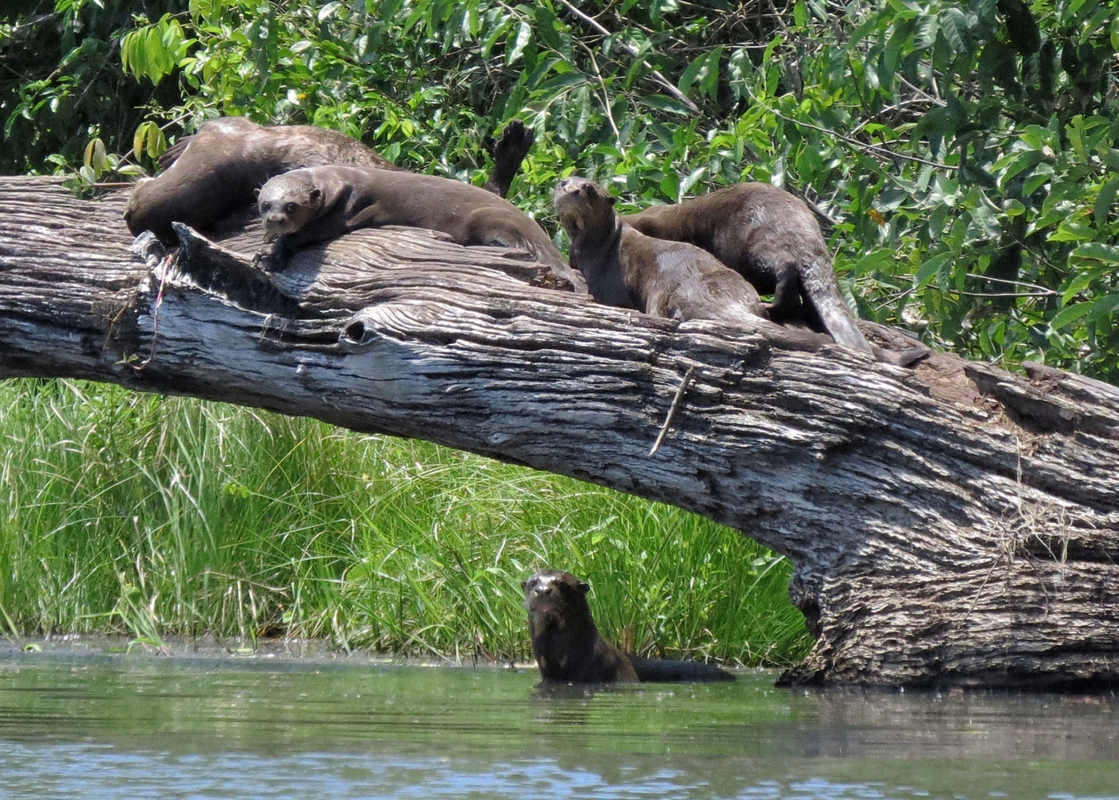Amazon Trip - Giant River Otters in Extinction.
The giant otter (Pteronura brasiliensis)
is a critically endangered species of aquatic mammal that inhabits various regions of South America. Although its distribution extends over several countries, its presence in Ecuador is limited to main rivers, tributaries and lake systems of the Amazon region, below 250 meters of altitude. However, the lack of detailed information on the species and its population hampers conservation efforts.
Giant otters face numerous threats that have contributed to their decline. The contamination of aquatic ecosystems due to oil activity, the use of fertilizers and pesticides in monocultures, indiscriminate fishing with dynamite or chemicals, mining activity, uncontrolled tourism and human colonization represent significant dangers for their survival. Although hunting of these otters is sporadic today, it is concerning, especially in areas where populations are beginning to recover.
The lack of precise information on the distribution and population estimates of the giant otter in Ecuador highlights the importance of implementing a monitoring program in the Yasuní National Park. This protocol seeks to provide a standardized methodological tool to observe the population trends of the species and evaluate the effectiveness of conservation efforts. In addition, it seeks to establish comparisons with other areas and regions to obtain a broader vision of the situation of the species.
Regarding the characteristics and behavior
of giant otters, they are diurnal animals that live in family groups. Communicating through sounds, they spend several hours a day fishing together. Its favorite places to rest are fallen logs on the banks of rivers and lagoons, which facilitates its observation in areas little affected by human presence. Individual identification is based on the white or yellowish-white markings on each otter's throat and neck, which have unique patterns. Photographing or filming individuals and their spot patterns is crucial for identification and cataloging.
The proposed protocol is developed through canoe navigation through the main rivers, tributaries and lagoons of the previously defined sampling area. It is recommended to use low powered motors or rowing to avoid disturbing the otters with the noise of the motors. During navigation, direct and indirect records of otter presence should be sought, such as sightings, tracks, latrines, and burrows. Direct sightings must be documented with photographs, noting the location, date, area and the exact number of individuals observed.
Sampling is carried out in the dry or low water season, generally between the months of November and February. At the end of the day, a provisional camp is established to continue sampling the next day and thus cover .
Description:
The giant river otter is the largest otter species in the world. It can reach a length of up to 1.8 meters and a weight of up to 30-35 kilograms. Its body is elongated and streamlined, with dense, dark brown fur. Its legs are short and strong, and have webbing that allows it to swim and dive efficiently.
Habitat and Distribution: Giant river otters are found in the freshwater rivers and lakes of the Amazon region, including Manu National Park. They prefer aquatic habitats with calm waters, such as lakes, lagoons and river courses. They are excellent swimmers and adapt well to aquatic ecosystems.
Behavior and Feeding: Giant river otters are primarily carnivorous, feeding on a variety of aquatic prey including fish, crustaceans, crabs, amphibians, and small mammals. They are skilled hunters and spend most of their time in the water, using their sharp claws and powerful teeth to capture and dismember their prey.
Ecological importance: These otters play a fundamental role in the aquatic ecosystem. Their diet and hunting behavior help regulate populations of fish and other aquatic species, maintaining a balance in river ecosystems. In addition, their burrowing activity can influence the structure of riparian habitats.
Conservation: The giant river otter is listed as an endangered species. Habitat loss, illegal hunting, and contamination of water bodies are some of the main threats they face. Manu National Park and other protected areas play a vital role in the conservation of this species, providing safe habitats and promoting awareness and protection of giant river otters.

No hay comentarios:
Publicar un comentario